
Newsletter of the Shell Club of Sydney
NSW Branch, The Malacological Society of Australasia Limited ACN 067 894 848
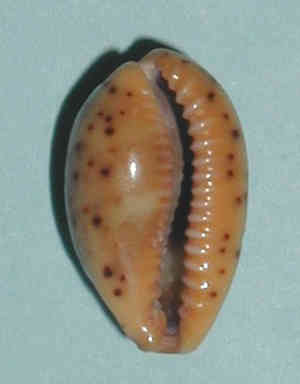
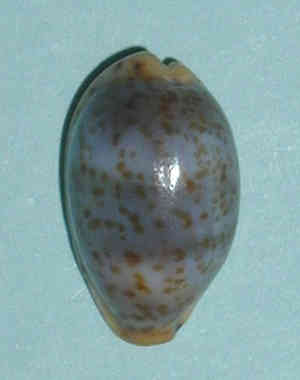
Cypraea humphreysii Collected Woolgoolga Headland at Easter
Courtesy David Tarrant
News
Dear Friends,
Karen gave birth at 11:53pm on the 29/03/2002 to Andrew James in the delivery suite of The Royal Hospital Women at Randwick after an induced labour. Andrew weighed 7lbs/10oz and was 56 cm in length at birth. Karen was in the anti-natal ward because the Easter rush finds the hospital very busy.
Chris & Karen Barnes
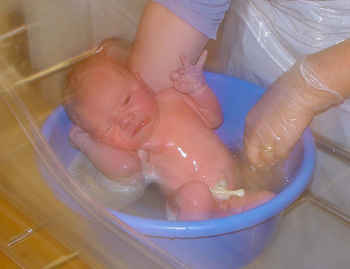
If you have spare shells and would like to find someone to swap with, try listing some of them on this page:
(Karens baby is not for swap)
EVENTS AT JERVIS BAY, N.S.W.
By John Franklin
The 30th December 2001 was a fairly rare day for southern New South Wales, in that the weather on the coastal front was simply divine. Jervis Bay skies were clear blue with the sun beaming down its very hot permeating rays as we made our way slowly through the short rough bush track to Callala Beach. The
beach is located in the Peronian region, south of Nowra, New South Wales on the beautiful south coast and almost in the centre of Jervis Bay.
We had decided to go for a swim and being part of the culture for "beyond the breakers swimming", we took off through the surf. Reaching our destination, we commenced swimming in relatively calm water beyond the swell of the ocean, but in parallel with the shoreline. The water was translucent, reflecting diffuse patterns of blue and green, as we swam laboriously along.
As it happened the tide was fairly low and we were swimming in about a metre and a half of water when suddenly a
rather small dark shadow appeared on the sandy ocean floor. Upon investigation it was found that the shadow was caused by the ambulatory movements of Cymbiola magnifica (Gebauer 1802). The colour of the shell was predominantly brown with grey patches and the length of the shell was judged to be about 240mm (a large hand-span).
We swam around the shell for about ten minutes observing the rather large, soft body pulling its shell over the rivulets in the sandy bottom. For the future, we could only speculate on how this beautiful creature will combat the exigencies as they arise.
Excursion to Woolgoolga NSW
By Steve Dean
On 31st March 2002, during Easter, David Tarrant and family took me shell collecting at their favourite beach wash location. The beach is near Woolgoolga in Northern NSW and shells can be collected at all tides. It is very popular with local shell collectors. There are people collecting there most days.
Fortunately on the day we went it was very windy and raining on and off. Based on the amount of shells we found David felt we must have been the first there on the day.
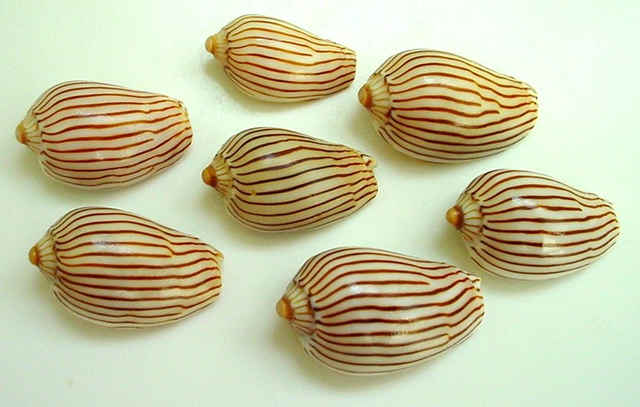
As is common in this part of NSW there were large numbers of dead Amoria zebra
in various sizes and states of wear. The only fresh dead ones I found were relatively small. David found some larger ones. He sells the good ones at the local markets along with
the shells he imports from overseas.
There were some species of Cowrie that are not readily available further south in Sydney. Ones I collected included
Cypraea staphylaea, Cypraea limacinea and many large
Cypraea felina.
We also found a couple of Cypraea humphreysi. (See front
cover) These are only common in small pockets along the coast, and Woolgoolga is one of these.
There were many Cypraea xanthodon, caputserpentis, gracilis, errones, erosa, vitellus,
and a smaller number of Cypraea minoridens. David's 8 and 6 year old boys were active in collecting the common Cowries. They reconfirmed my
theory that children spot cowries quicker than adults, even when the adults are on all fours.
I found two Trivia oryza, one the same size as most of the ones I find in Sydney
(2.5mm) and one almost double the size (4.1mm), quite a large size variation for one location. I assume they may have washed in from different habitats.
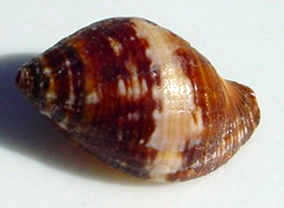 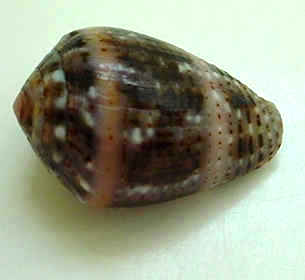
We got a Nassa serta,(with worn apex) as well as Conus
coronatus. I have not personally found either of these in NSW before.
I also collected a variety of colour patterns of the northern form of Cominella eburnea fm filicea
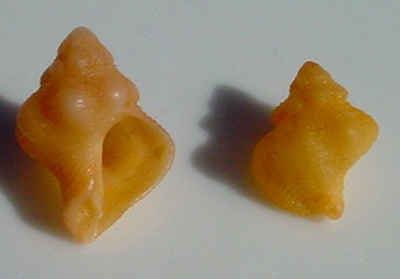
David got me to look out for Mipus arbutum, an uncommon Muricid that is endemic to northern NSW only - I found two. If David had not shown me what they looked like I would have thought they were juveniles of something larger and common, and I would not have collected them.
There were also very red Chicoreus denudatus in reasonable condition.
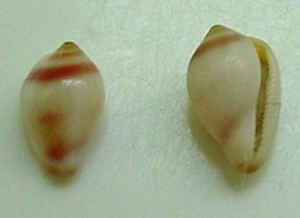
We found a number of Proterato lachryma - apparently more common than they are in Sydney.
There were only two species of Marginella picked up, one being Mesoginella
turbinate.
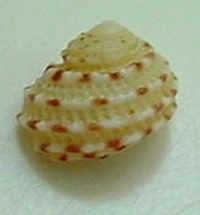
The only Euchelus ampullus in my collection was one I live collected on the club excursion to Norah Head last year. At Woolgoolga I found a second specimen.
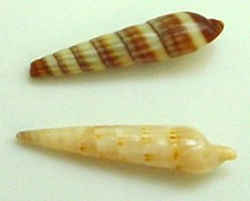
As well as Hastula brazieri
there was another Terebra that I have yet to identify.
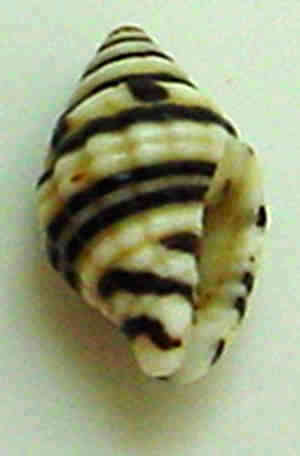
I found an Engina lineata. David and I considered this unusual this far South.
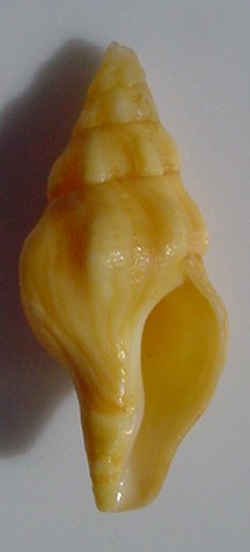
The other local endemic shell I found was Nodopelagia brazieri. (Peristernia brazieri) The one I found was in poor condition, so David gave me a better specimen from his home stock. This species also has a very limited geographic range.
I also stocked up on Pyrene testudinaria as I did not have many in my collection, and the colour varied significantly in the ones amongst the beach wash.
Most species referred to above were collected in good condition, some fresh dead and all acceptable for display in my collection. There were many other shells on the beach, but their condition was poor as the beach wash included large amounts of rocks, and the surf was rough.
In summary an excellent hour or so of collecting. It pays to go with someone with local knowledge of both
locality, and expected species.
Tropical Holiday with the Kids
By David Tarrant
Early last year we decided that it was time to have a tropical island holiday. But where should we go?
As most of you are aware, when travelling with children of pre-school and primary school age there are a number of factors that need to be taken into account.
Firstly, the distance to the destination should be as short as possible. By the time you board the plane, down the airline's complimentary soft drink, spread your toys along the whole row of seats, complete the 'Max Altitude' activity book, eat the meal and listen to each channel on the headset for at least 10 seconds it should, ideally, be time to land.
Secondly, the location should be 'kid safe'. That is, no dangerous rips, currents, crocodiles, cliffs, strange diseases or unfriendly locals.
Thirdly, it should have plenty of things to do and a ready supply of coco pops, two-minute noodles and sausages (after all, they are on holidays!).
Lastly, from the parent viewpoint, the price must be right. There is no point in taking the family to a luxury resort if you can't afford to leave your room!
Well, the destination that we chose was Vanuatu. Vicki and I had been there on a couple of previous occasions and the 'kids fly free' offer was too good to refuse. Vanuatu is only about two hours flying time from Brisbane, it has lots of sheltered bays and lagoons for snorkelling, it is full of friendly locals and, of course, it has shells!
Our group consisted of my wife Vicki and myself, our two boys Daniel (7) and Luke (4), my brother Andrew and his wife Kerrie, their two children Nicholas (11) and Johanna (9), and Kerrie's sister Wendy.
We flew out of Brisbane in the late afternoon and, after making adjustments for time zones, arrived at Pacific Lagoon apartments on the shores of Erakor Lagoon just before midnight.
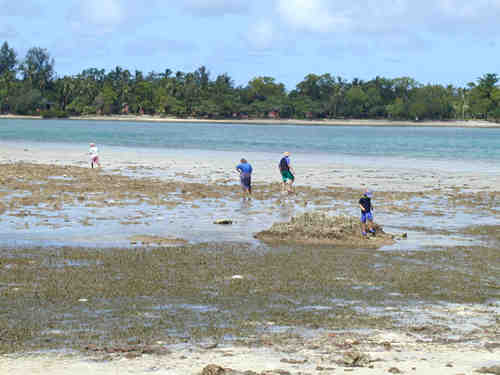
Searching the shore of Erakor Lagoon
The Lagoon is located about 10 minutes drive from the centre of Vila and contains a variety of habitats including sandy areas, weed beds, coral bommies and patches of coral. The mouth of the lagoon is separated from the Pacific Ocean by a coral reef which is largely exposed at low tide and which provides a great place for both reef walking and snorkelling.
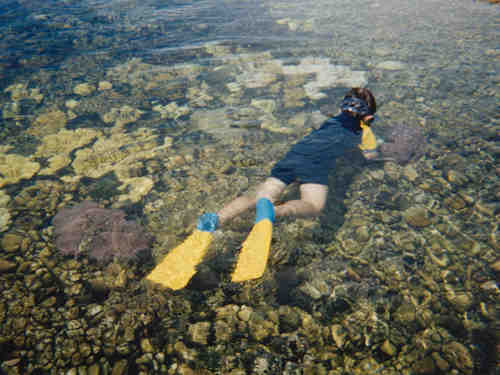
Luke in a coral pool at the entrance to Erakor Lagoon
Pacific Lagoon apartments are self-contained, so the sausages and two-minute noodles were not a problem. The high tide laps the front steps, so we didn't have far to go to look for shells.
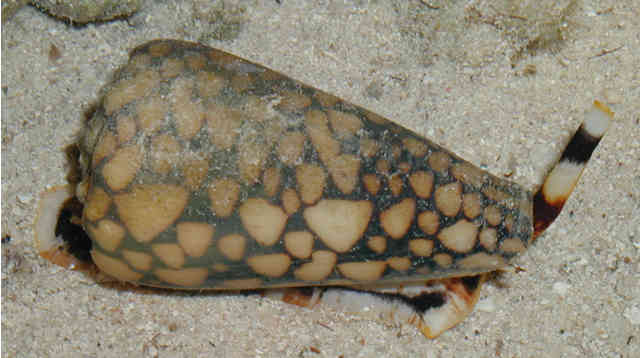
Conus marmoreus
The most conspicuous creatures in the lagoon are the 200 mm horned starfish
Protoreaster nodosus. They are abundant in all areas and come in a wide variety of colours. The kids ran a competition to see who could find the most 4-legged and 6-legged specimens.

Protoreaster nodosus
Daniel reckoned that he had won hands down when he found one with 7-legs.
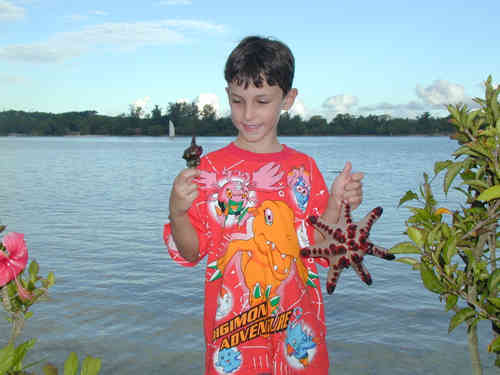
Daniel with Pleuroploca trapezium and 7-leg starfish
Much of the lagoon is less than 3 metres deep, so it provided great snorkelling for the kids. All four of them found some nice shells, particularly cowries and cones. They all soon learned that the areas around the bases of the coral bommies were the best places to look. We only kept dead shells, but spent a lot of time looking for live shells just to see what was there.
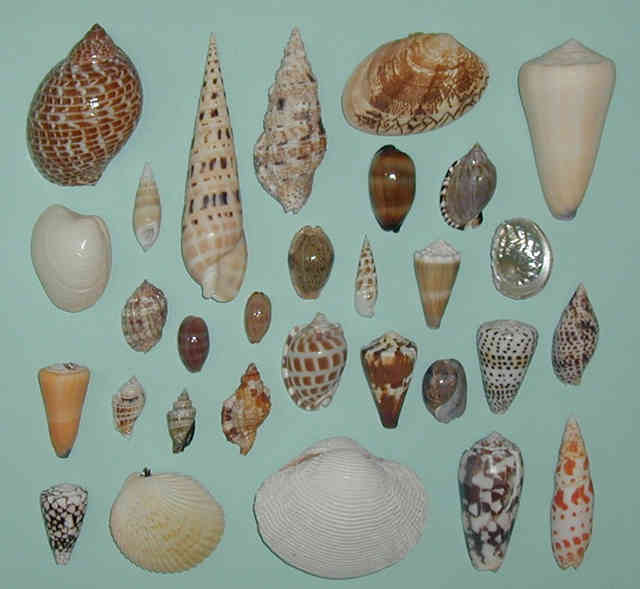
Dead shells collected Erakor Lagoon
Erakor Island, which lies roughly in the centre of the lagoon, can be accessed by a free ferry and provides a good base for snorkelling activities around the lagoon.
One of our favourite shade trees on the island turned out to be the home of a brightly coloured green skink. We managed to photograph him on one occasion, but for most of the time he proved to be rather shy.

Green skink on Erakor Island
As is usually the case, the best way to find live shells around the lagoon is to hunt at night. A good variety was found in front of the apartments including
Cypraea tigris, Cypraea talpa, Cypraea lynx, Conus marmoreus, Vexillum plicarium, Vexillum vulpecula
and several species of Natica, Nerita, Mitra, Cerithium and
Turrids.
Cypraea anulus, Cypraea moneta and Strombus gibberulus were abundant, while
Conus coronatus, Conus pulicarius, Conus lividus and many smaller species were common.
One specimen of Cypraea tigris was found by us on day two and then found every day until we left on day nine.
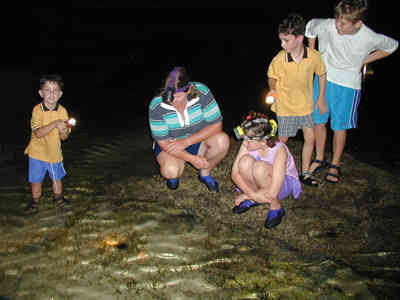
Night Hunting
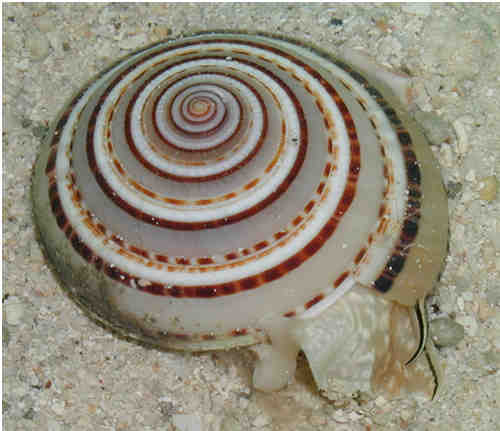
Architectonica perspectiva
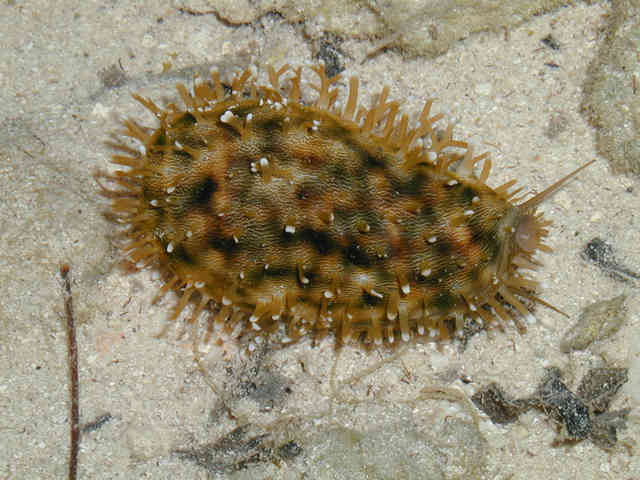
Juvenile Cypraea tigris
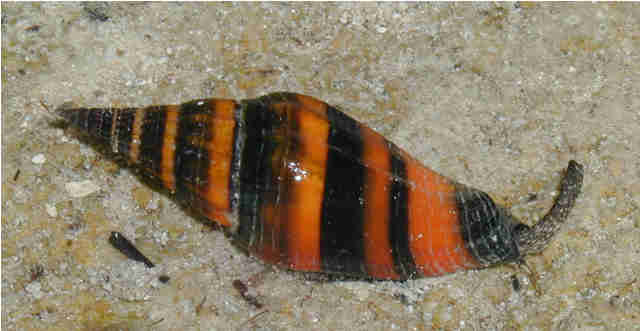
Vexillum vulpecular
During our stay we caught up with local minibus operator Napau. He is attempting to build up a family tourist business and offers many different tours. His other claim to fame is that he is a member of the national cricket team.

Napau off to cricket practice
On one of our trips with Napau we visited his Cousin Mangua (forgive the spelling) at his property located near the end of Devils Point on the south side of Mele Bay. Now, after travelling about 20 kilometres along a dirt road through virtually uninhabited countryside you don't expect to meet anyone with very much knowledge of the outside world. However, when Andrew mentioned that his home town was Grafton, much to our surprise Mangua raised his arms in a circle above his head and exclaimed 'purple flowers'. Most Aussies may be aware of Grafton's Jacaranda Festival, but I don't think that it is on the Vanuatu school curriculum. Then, when I mentioned Coffs Harbour, Mangua stretched out his arms and said in a loud voice 'Big Banana'. By this time we reckoned that it was time to start asking some questions.
It turns out that Mangua was a member of the Vanuatu basketball team that toured NSW a few
years back. Thus his knowledge of NSW country towns.
Mangua's property adjoins an idyllic little bay which provides excellent snorkelling for both adults and the kids. A small island in the middle of the bay provides a good place to have a rest when the legs start to become tired.
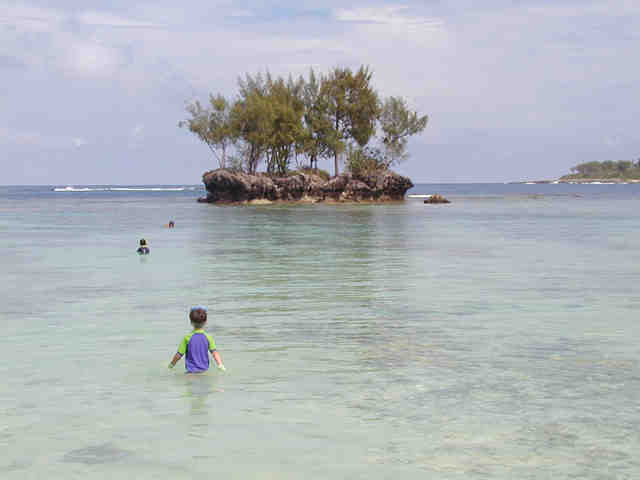 Kids snorkelling at Mangua's bay Kids snorkelling at Mangua's bay
Several hundred metres offshore from the bay there are reefs containing some of the best coral that we have seen. The shelling was relatively poor, so we spent most of the time snorkelling and enjoying the coral and fish life. Parts of the reef also contained large numbers of small clam shells. We had a brief visit from a green turtle, but he left in a hurry so that he wouldn't end up on Mangua's dinner menu!
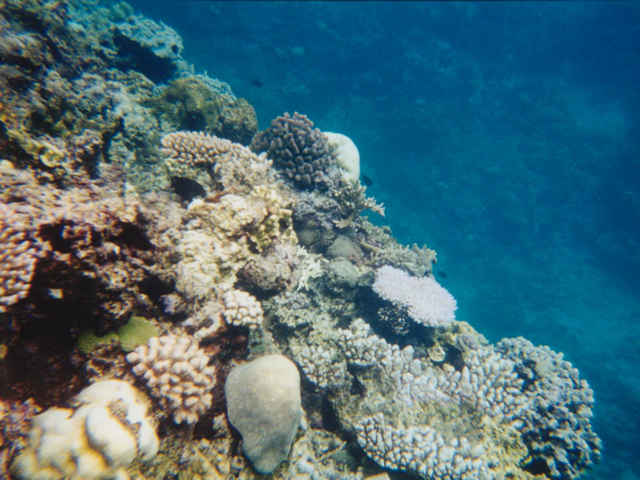
Drop-off at Mangua's bay
Mangua also presented us with a Nautilus pompilius which he had collected on the beach a few days earlier.
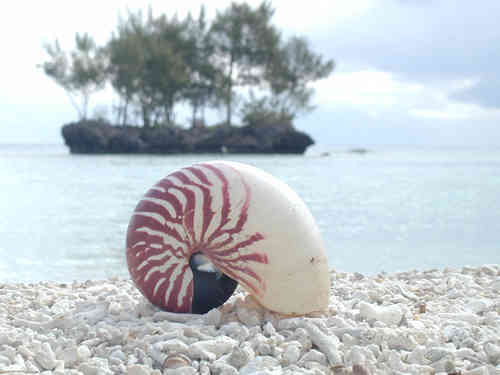
Mangua's Nautilus
From Mangua's place we moved back along Devils Point to search in the coral rubble for shells. We found many species of Cypraea including asellus, bistrinotata, catholicorum, childreni, cicercula, depressa, globulus, helvola, kieneri, margarita, mariae, minoridens, scurra and testudinaria. Cones found by us included cylindraceus, geographus, mitratus, retifer and tulipa. We also found various Cymatium, Drupa, Strombus, Turbo, Trochus and a baby Nautilus. Some of the shells were rather worn, but many were in quite good condition.
The kids certainly had no trouble filling their buckets and, during breaks from the shelling, they also had fun playing with Napau's daughter and her friend who had also come along for the ride.
The tide was relatively high, so we didn't search for live shells. Given the amount of dead shell in the rubble, a SCUBA dive off the adjacent reef would probably produce some nice shells.
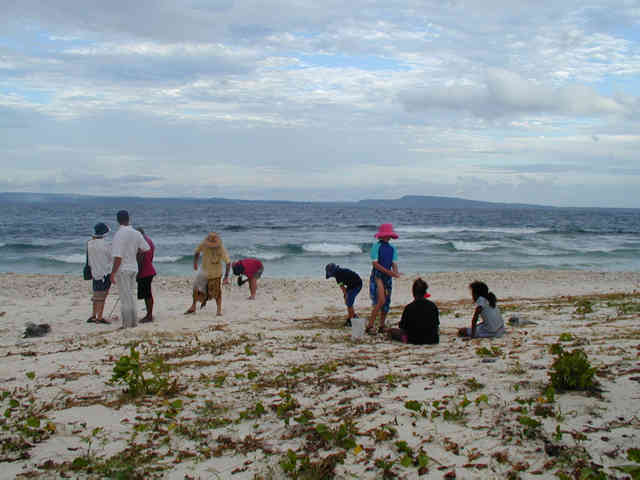
Shelling at Devils Point
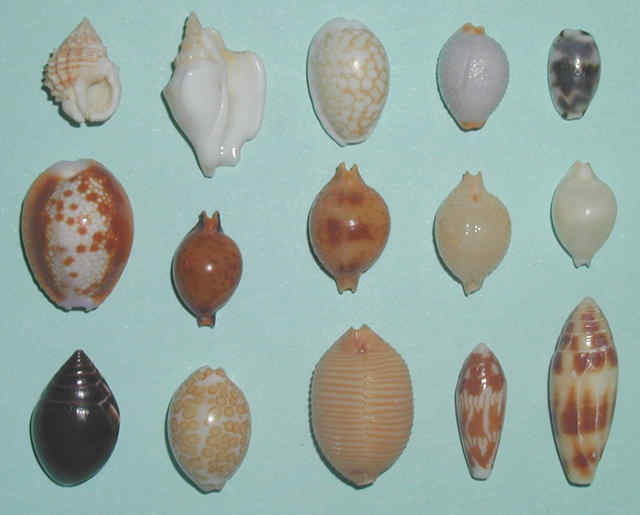
Some of the small shells collected from beaches at Devil's Point
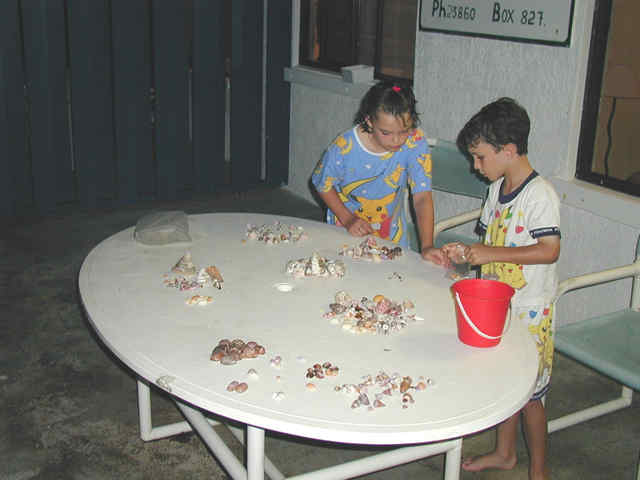
Johanna and Daniel dividing the 'Loot'
We also went with Napau on a tour around the main island of Efate. This tour took us to the Trochus Shell factory and to many lovely snorkelling spots, the best of which was probably Undine Bay. The bay contained numerous colourful bommies surrounded by crystal clear water. The sand was littered with
Strombus gibberulus and we also found Trochus niloticus, Lambis lambis
and a number of species of cowries, cones, ceriths and other shells.
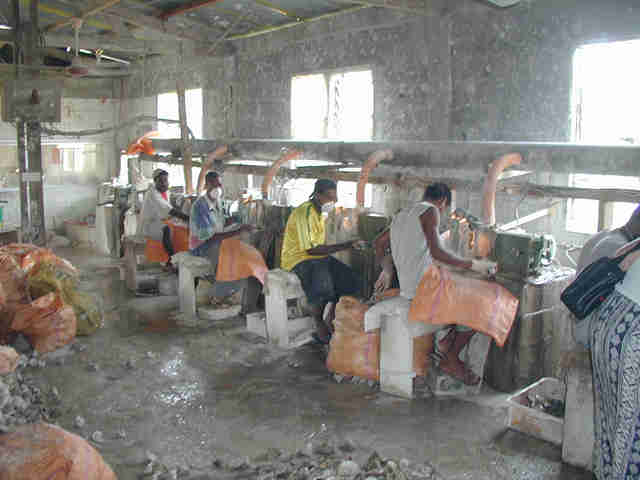
Vila Trochus Shell Factory

Daniel collecting at Banana Bay
Back at Erakor the sea became very calm and we were able to snorkel along the drop off on the ocean side of the reef at the entrance to the lagoon. Here we found shells including
Cypraea talpa and a very attractive live Lambis scorpio which we took back to the apartment to be photographed before being released.
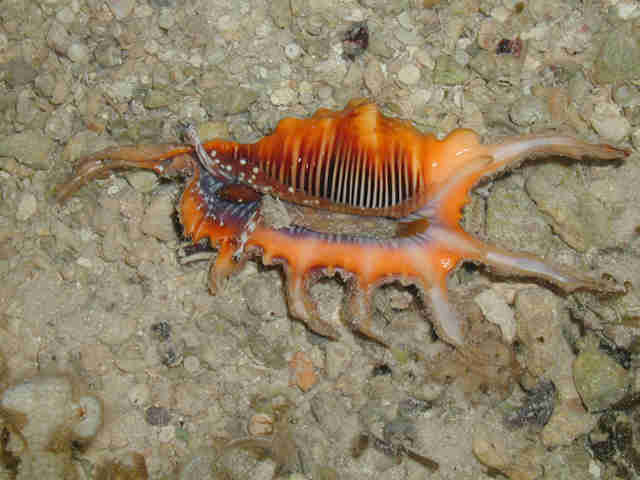
Lambis scorpio
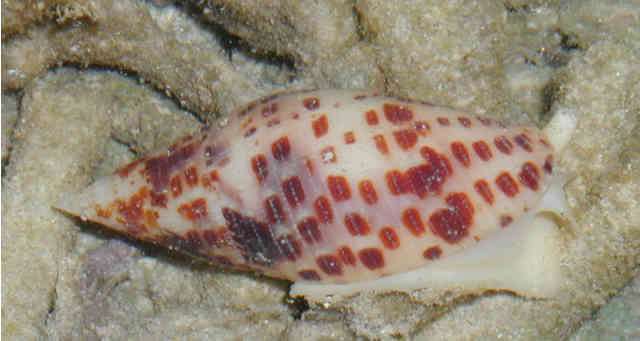
Mitra cardinalis
At various spots around Efate the locals have set up stalls selling shells and other items including World War II Coca Cola bottles. The stalls are unmanned and rely on an honesty system. The shells for sale are mostly the more common large shells such as Cones, Cowries and Turbo.
Shells can also be purchased at the Vila market. Again the shells are mostly the larger, more attractive Cones and Cowries, with
Cypraea tigris, Cypraea mauritiana and Cypraea lynx being prominent.
Turbo marmoratus, Charonia tritoni, Nautilus pompilius and
Lambis truncata are also usually available.
On an earlier trip I was able to purchase a reasonable number of Oliva
rubrolabiata, but there were none on offer this time. A couple of shops in Vila are now selling shells that almost certainly come from the Philippines.
Our nine days passed very quickly and before we knew it we were on the plane and on our way home. Vanuatu had proven itself to be a great place to take the kids for a holiday. Before we arrived home they were already asking when we would be going back again. Maybe next year!
A Rare Cone
By David Tarrant
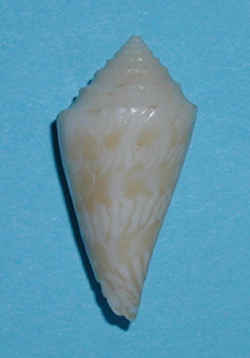 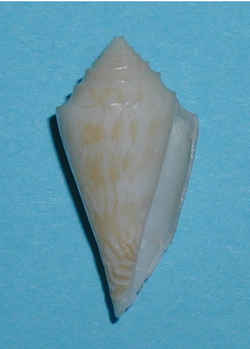
Late last year a Conus howelli was trawled in about 80 fathoms off Coffs Harbour. The shell was dead and has a large break in the lip, but still retains some of its original colour. It measures 30.5 mm in length and 15.6 mm wide at the shoulder.
This is the first Conus howelli that I have come across.
Cone 'guru' John Singleton has advised that this is the first specimen known to be collected in Australia since 1972. The 1972 shell, which is in John's collection, is a good dead shell trawled off Eden. Most NSW shells have come from the southern half of the state. The species has also been reported from Lord Howe Island and Norfolk Island. Reports of the species from Southern Queensland have not been confirmed. John points out that the shell illustrated in Marsh and Rippingale's "Cone Shells of the World" was mistakenly given Queensland data, and the shell actually comes from NSW.
John also kindly provided me with a copy of an article from the New Zealand Journal of Zoology, 1981, Volume 8, which provides information on 29 specimens of
Conus howelli dredged in deep water to the North of New Zealand by National Museum of N.Z. staff in January 1979. The total number of shells from Australia may be less than the 29 shells taken in this single New Zealand expedition.
National Shell Show, Brisbane March 2002.
Summary by Steve Dean
The picture below shows 70% of the dealer tables. There were a lot more shells and dealers than the shot conveys as it is taken down the tables. There were four rows of dealer tables and the exhibits were around the edges of the room. The room lighting was uneven hence the bright background. The buy swap and sell and food were in different rooms downstairs.
Ron is in the floral shirt sitting at his booth mid left. Bob Reid is standing further left. I am in the horizontal striped shirt still further left at the tables Adrian and I had taken to try to reduce some of our accumulated shell stock. Patty who took this photo has her book tables directly behind Ron's head, and Maureen is buying shells at a far table immediately above Ron's head. Adrian is in the distance 'sticking out of Bob's head' negotiating a swap of shells for sharks teeth with David Tarrant.
Two of our member exhibited and both got awards (John Dunkerley and Maureen Anderson).
Some of our other members in attendance included Ashley, Stephanie, Noel, John Franklin and Catherine.
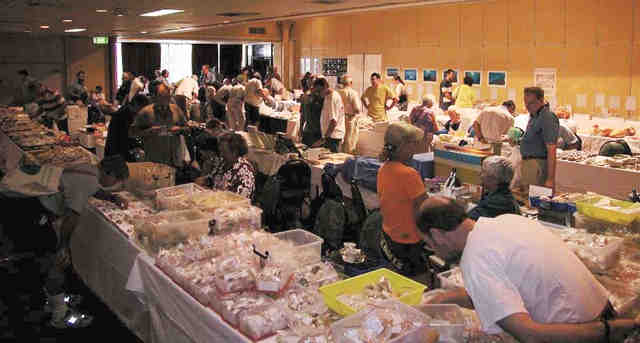
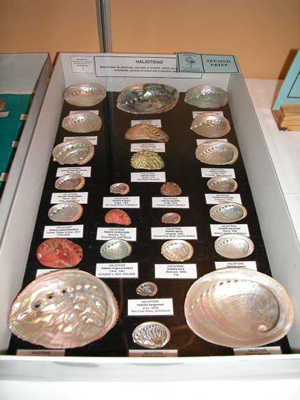
Example of a display:
At the National Shell Show, Brisbane
Haliotidae, Second prize.
|

























 Kids snorkelling at Mangua's bay
Kids snorkelling at Mangua's bay











